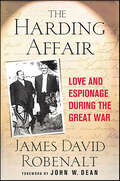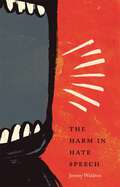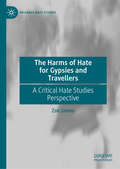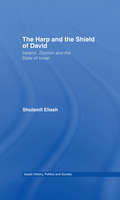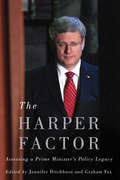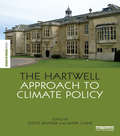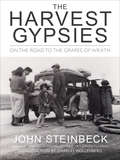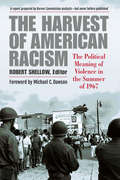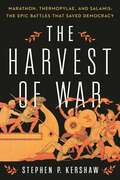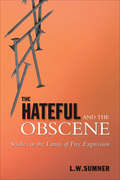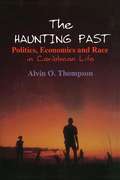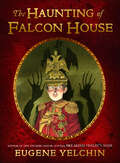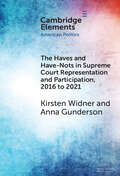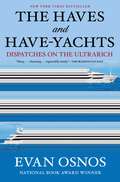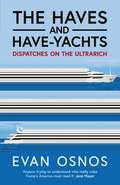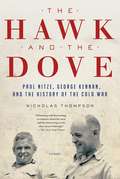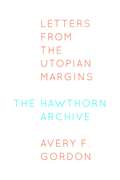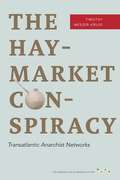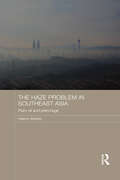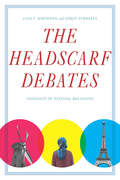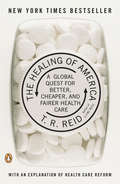- Table View
- List View
The Harding Affair: Love and Espionage During the Great War
by James David RobenaltWarren Harding fell in love with his beautiful neighbor, Carrie Phillips, in the summer of 1905, almost a decade before he was elected a United States Senator and fifteen years before he became the 29th President of the United States. When the two lovers started their long-term and torrid affair, neither of them could have foreseen that their relationship would play out against one of the greatest wars in world history--the First World War. Harding would become a Senator with the power to vote for war; Mrs. Phillips and her daughter would become German agents, spying on a U. S. training camp on Long Island in the hopes of gauging for the Germans the pace of mobilization of the U. S. Army for entry into the battlefields in France.Based on over 800 pages of correspondence discovered in the 1960s but under seal ever since in the Library of Congress, The Harding Affair will tell the unknown stories of Harding as a powerful Senator and his personal and political life, including his complicated romance with Mrs. Phillips. The book will also explore the reasons for the entry of the United States into the European conflict and explain why so many Americans at the time supported Germany, even after the U. S. became involved in the spring of 1917. James David Robenalt's comprehensive study of the letters is set in a narrative that weaves in a real-life spy story with the story of Harding's not accidental rise to the presidency.
The Harm in Hate Speech
by Jeremy WaldronEvery liberal democracy has laws or codes against hate speech-except the United States. For constitutionalists, regulation of hate speech violates the First Amendment and damages a free society. Against this absolutist view, Jeremy Waldron argues powerfully that hate speech should be regulated as part of our commitment to human dignity and to inclusion and respect for members of vulnerable minorities. Causing offense-by depicting a religious leader as a terrorist in a newspaper cartoon, for example-is not the same as launching a libelous attack on a group’s dignity, according to Waldron, and it lies outside the reach of law. But defamation of a minority group, through hate speech, undermines a public good that can and should be protected: the basic assurance of inclusion in society for all members. A social environment polluted by anti-gay leaflets, Nazi banners, and burning crosses sends an implicit message to the targets of such hatred: your security is uncertain and you can expect to face humiliation and discrimination when you leave your home. Free-speech advocates boast of despising what racists say but defending to the death their right to say it. Waldron finds this emphasis on intellectual resilience misguided and points instead to the threat hate speech poses to the lives, dignity, and reputations of minority members. Finding support for his view among philosophers of the Enlightenment, Waldron asks us to move beyond knee-jerk American exceptionalism in our debates over the serious consequences of hateful acts.
The Harms of Hate for Gypsies and Travellers: A Critical Hate Studies Perspective (Palgrave Hate Studies)
by Zoë JamesGypsies and Travellers have often been overlooked as victims of hate crime and discrimination. This book redresses that exclusion by shining a light on the harms of hate experienced by Gypsies and Travellers in the UK. In doing so James explores how hate permeates all aspects of their lives and identifies the hate crimes, incidents, and speech that they are subject to. It goes on to explore how hate against Gypsies and Travellers occurs as discrimination, social exclusion and criminalisation and how that hate is embedded within the language and practice of neoliberal capitalism. This book provides new insights to critical criminology and ways of understanding hate by using the critical hate studies perspective to gain a full appreciation of the harms of hate. As a consequence of this, the book is able to do justice to Gypsies' and Travellers' experiences of hate by extrapolating how harms manifest and the impact they have on Gypsies’ and Travellers’ social and personal identities. The book explains and acknowledges how hate harms imbue Gypsies' and Travellers' daily lives, including common events of serious abuse and assault, regular ill-treatment in provision of services, and everyday micro-aggressions. It argues hate experienced by Gypsies and Travellers can only be fully recognised through an analysis of the neoliberal capitalist context within which it occurs and the harmful subjective experience it engenders. The author’s expertise in this area, having carried out research with Gypsies and Travellers for 25 years, underpins the book with excellent empirical knowledge and research-informed discussion.
The Harms of Work: An Ultra-Realist Account of the Service Economy (Studies in Social Harm)
by Anthony LloydAs the percentage of people working in the service economy continues to rise, there is a need to examine workplace harm within low-paid, insecure, flexible and short-term forms of ‘affective labour’. This is the first book to discuss harm through an ultra-realist lens and examines the connection between individuals, their working conditions and management culture. Using data from a long-term ethnographic study of the service economy, it investigates the reorganisation of labour markets and the shift from security to flexibility, a central function of consumer capitalism. It highlights working conditions and organisational practices which employees experience as normal and routine but within which multiple harms occur. Challenging current thinking within sociology and policy analysis, it reconnects ideology and political economy with workplace studies and uses examples of legal and illegal activity to demonstrate the multiple harms within the service economy.
The Harold Nicolson Diaries: 1907-1964
by Harold NicolsonOne of the great 20th century political diaries'Brilliant, riveting stuff' TRIBUNE'One stops to marvel at the achievement. Honesty, decency, modesty, magnanimity, are stamped on every page, as evident as the wit' EVENING STANDARD'A tremendous read' SPECTATORHarold Nicolson was one of the three great political diarists of the 20th century (along with Chips Channon and Alan Clark). Nicolson was an MP (Conservative, 1935-45, who also flirted with Labour after WWII). He had previously been in the Foreign Office and attended the Paris Peace Conference in 1919, and material from this period is included in this new edition for the first time. Nicolson never achieved high office, but rarely a day went by when he didn't record what was going on at Westminster. He socialised widely, was married to the poet and author Vita Sackville-West, and together they created the famous garden at Sissinghurst. Both were bi-sexuals and had affairs outside their marriage. This new edition also draws on diary entries and letters previously considered too sensitive for inclusion. The diversity of Harold Nicolson's interests and the irony in his writing make his diary a highly entertaining record of his life and times, as well as a document of great historical value.
The Harold Nicolson Diaries: 1907-1964
by Harold NicolsonOne of the great 20th century political diaries'Brilliant, riveting stuff' TRIBUNE'One stops to marvel at the achievement. Honesty, decency, modesty, magnanimity, are stamped on every page, as evident as the wit' EVENING STANDARD'A tremendous read' SPECTATORHarold Nicolson was one of the three great political diarists of the 20th century (along with Chips Channon and Alan Clark). Nicolson was an MP (Conservative, 1935-45, who also flirted with Labour after WWII). He had previously been in the Foreign Office and attended the Paris Peace Conference in 1919, and material from this period is included in this new edition for the first time. Nicolson never achieved high office, but rarely a day went by when he didn't record what was going on at Westminster. He socialised widely, was married to the poet and author Vita Sackville-West, and together they created the famous garden at Sissinghurst. Both were bi-sexuals and had affairs outside their marriage. This new edition also draws on diary entries and letters previously considered too sensitive for inclusion. The diversity of Harold Nicolson's interests and the irony in his writing make his diary a highly entertaining record of his life and times, as well as a document of great historical value.
The Harp and the Shield of David: Ireland, Zionism and the State of Israel (Israeli History, Politics and Society)
by Shulamit EliashEliash examines the relationship between Ireland and the Zionist movement, and the state of Israel from the context of Palestine’s partition and the delay in Ireland’s recognition of the State of Israel until 1963. Analyzing the Irish attitude to the partition of Palestine through an analogy with that of Ireland, this engaging text compares both the Irish and Zionist views on the partition plans of 1937 and 1947. The study underscores the contrast between Ireland’s separatist policy and its sparse diplomatic connections on the one hand, and Israel’s global diplomacy on the other, and discusses how this gap contributed to Ireland’s delay in recognizing the State of Israel. Shedding light on Irish and Israeli foreign policy, the book also calls into question the ability of small states to form independent foreign policy, the Vatican’s influence on devout Catholic states like Ireland, and the role of Irish and Jewish diasporas in the US.
The Harper Factor: Assessing a Prime Minister's Policy Legacy
by Jennifer Ditchburn Graham FoxPolitical legacy is a concept that is often tossed around casually, hastily defined by commentators long before a prime minister leaves office. In the case of the polarizing Stephen Harper, clear-eyed analysis of his tenure is hard to come by. The Harper Factor offers a refreshingly balanced look at the Conservative decade under his leadership. What impact did Harper have on the nation's finances, on law and order, and on immigration? Did he accomplish what he promised to do in areas such as energy and intergovernmental affairs? How did he change the conduct of politics, the workings of the media, and Parliament? A diverse group of contributors, including veteran economists David Dodge and Richard Dion, immigration advocate Senator Ratna Omidvar, Stephen Harper's former policy director Paul Wilson, award-winning journalists such as Susan Delacourt, and vice-provost of Aboriginal Initiatives at Lakehead University Cynthia Wesley-Esquimaux, make reasoned cases for how Harper succeeded and how he fell short in different policy domains between 2006 and 2015. Stephen Harper's record is decidedly more nuanced than both his admirers and detractors will concede. The Harper Factor provides an authoritative reference for Canadians on the twenty-second prime minister's imprint on public policy while in office, and his political legacy for generations to come.
The Harper Factor: Assessing a Prime Minister's Policy Legacy
by Jennifer Ditchburn and Graham FoxPolitical legacy is a concept that is often tossed around casually, hastily defined by commentators long before a prime minister leaves office. In the case of the polarizing Stephen Harper, clear-eyed analysis of his tenure is hard to come by. The Harper Factor offers a refreshingly balanced look at the Conservative decade under his leadership. What impact did Harper have on the nation’s finances, on law and order, and on immigration? Did he accomplish what he promised to do in areas such as energy and intergovernmental affairs? How did he change the conduct of politics, the workings of the media, and Parliament? A diverse group of contributors, including veteran economists David Dodge and Richard Dion, immigration advocate Senator Ratna Omidvar, Stephen Harper’s former policy director Paul Wilson, award-winning journalists such as Susan Delacourt, and vice-provost of Aboriginal Initiatives at Lakehead University Cynthia Wesley-Esquimaux, make reasoned cases for how Harper succeeded and how he fell short in different policy domains between 2006 and 2015. Stephen Harper’s record is decidedly more nuanced than both his admirers and detractors will concede. The Harper Factor provides an authoritative reference for Canadians on the twenty-second prime minister’s imprint on public policy while in office, and his political legacy for generations to come.
The Hartwell Approach to Climate Policy (The Earthscan Science in Society Series)
by Steve Rayner Mark CaineThe Hartwell Approach to Climate Policy presents a powerful critique of mainstream climate change policies and details a set of pragmatic alternatives based on the Hartwell Group’s collective writings from 1988-2010. Drawing on a rich history of heterodox but increasingly accepted views on climate change policy, this book brings together in a single volume a series of key, related texts that define the ‘Hartwell critique’ of conventional climate change policies and the ‘Hartwell approach’ to building more inclusive, pragmatic alternatives. This book tells of the story of how and why conventional climate policy has failed and, drawing from lessons learned, how it can be renovated. It does so by weaving together three strands of analysis. First, it highlights why the mainstream approach, as embodied by the Kyoto Protocol, has failed to produce real world reductions in greenhouse gas emissions and delayed real meaningful progress on climate change. Second, it explores the underlying political, economic, and technological factors which form the boundary conditions for climate change policy but which are often ignored by policy makers and advocates. Finally, it lays out a novel approach to climate change guided centrally by the goal of uplifting human dignity worldwide—and the recognition that this can only succeed if pursued pragmatically, economically, and with democratic legitimacy. With contributions from leading scholars in the field, this work presents a original critique of climate policy and a constructive primer for how to improve it.
The Harvest Gypsies: On the Road to the Grapes of Wrath (Library Of America John Steinbeck Edition Ser. #2)
by John SteinbeckA collection of newspaper articles about Dust Bowl migrants in California&’s Central Valley by the author of The Grapes of Wrath, accompanied by photos. Three years before his triumphant novel The Grapes of Wrath—a fictional portrayal of a Depression-era family fleeing Oklahoma during a disastrous period of drought and dust storms—John Steinbeck wrote seven articles for the San Francisco News about these history-making events and the hundreds of thousands who made their way west to work as farm laborers. With the inquisitiveness of an investigative reporter and the emotional power of a novelist in his prime, Steinbeck toured the squatters&’ camps and Hoovervilles of rural California. The Harvest Gypsies gives us an eyewitness account of the horrendous Dust Bowl migration, and provides the factual foundation for Steinbeck&’s masterpiece. Included are twenty-two photographs by Dorothea Lange and others, many of which accompanied Steinbeck&’s original articles. '&”Steinbeck&’s potent blend of empathy and moral outrage was perfectly matched by the photographs of Dorothea Lange, who had caught the whole saga with her camera—the tents, the jalopies, the bindlestiffs, the pathos and courage of uprooted mothers and children.&”—San Francisco Review of Books &“Steinbeck&’s journalism shares the enduring quality of his famous novel…Certain to engage students of both American literature and labor history.&”—Publishers Weekly
The Harvest of American Racism: The Political Meaning of Violence in the Summer of 1967
by Robert ShellowIn the summer of 1967, in response to violent demonstrations that rocked 164 U.S. cities, the National Advisory Commission on Civil Disorders, a.k.a. the Kerner Commission, was formed. The Commission sought reasons for the disturbances, including the role that law enforcement played. Chief among its research projects was a study of 23 American cities, headed by social psychologist Robert Shellow. An early draft of the scientists’ analysis, titled “The Harvest of American Racism: The Political Meaning of Violence in the Summer of 1967,” provoked the Commission’s staff in November 1967 by uncovering political causes for the unrest; the team of researchers was fired, and the controversial report remained buried at the LBJ Presidential Library until now. ? The first publication of the Harvest report half a century later reveals that many of the issues it describes are still with us, including how cities might more effectively and humanely react to groups and communities in protest. In addition to the complete text of the suppressed Harvest report, the book includes an introduction by Robert Shellow that provides useful historical context; personal recollections from four of the report’s surviving social scientists, Robert Shellow, David Boesel, Gary T. Marx, and David O. Sears; and an appendix outlining the differences between the unpublished Harvest analysis and the well-known Kerner Commission Report that followed it. “The [Harvest of American Racism] report was rejected by Johnson administration functionaries as being far too radical—politically ‘unviable’… Social science can play an extremely positive role in fighting racial and other injustice and inequality, but only if it is matched with a powerful political will to implement the findings. That will has never come from within an American presidential administration—that will has only been forged in black and other radical communities’ movements for justice. The political power for change, as incremental as it has been, has come from within those communities. Washington responds, it does not lead." —from the Foreword by Michael C. Dawson
The Harvest of War: Marathon, Thermopylae, and Salamis: The Epic Battles that Saved Democracy
by Stephen P. KershawThe year 2022 marks 2,500 years since Athens, the birthplace of democracy, fought off the mighty Persian Empire. This is the story of the three epic battles—Marathon, Thermopylae and Salamis—that saved democracy, forever altering the history of Europe and the West.In 2022 it will be 2,500 years since the final defeat of the invasion of Greece by Xerxes, the Persian king. This astonishing clash between East and West still has resonances in modern history—and has left us with tales of heroic resistance in the face of seemingly hopeless odds. The Harvest of War makes use of recent archaeological and geological discoveries in this thrilling and timely retelling of the story, originally told by Herodotus, the Father of History. In 499 BC, when the rich, sophisticated Greek communities of Ionia on the western coast of modern Turkey rebel from their Persian overlord Darius I, Athens sends ships to help them. Darius crushes the Greeks in a huge sea battle near Miletus and then invades Greece. Standing alone against the powerful Persian army, the soldiers of Athens' newly democratic state—a system which they have invented—unexpectedly repel Darius's forces on the planes of Marathon. After their victory, the Athenians strike a rich vein of silver in their state-owned mining district, and decide to spend the windfall on building a fleet of state-of-the-art warships. Persia wants revenge. The next Persian king, Xerxes, assembles a vast multinational force, constructs a bridge of boats across the Hellespont, digs a canal through the Mount Athos peninsula, and bears down on Greece. Trusting in their "wooden walls," the Athenians station their ships at Artemisium, where they and the weather prevent the Persians landing forces in the rear of the land forces under the Spartan King Leonidas at the nearby pass of Thermopylae. Xerxes's assault is a disastrous failure, until a traitor shows him a mountain track that leads behind the Greeks. Leonidas dismisses the Greek troops, but remains in the pass with his 300 Spartan warriors where they are overwhelmed in an heroic last stand. Athens is sacked by the Persians. Democracy is hanging by a thread. But the Athenians convince the Greek allies to fight on in the narrow waters by the island of Salamis. Despite the heroism of the Persian female commander Artemisia, the Persian fleet is destroyed. The Harvest of War concludes by exploring the ideas that the decisive battles of Marathon, Thermopylae, and Salamis mark the beginnings of Western civilization itself—and that Greece became the bulwark of the West—representing the values of peace, freedom, and democracy in a region historically ravaged by instability and war.
The Hateful and the Obscene: Studies in the Limits of Free Expression
by Leonard SumnerIn a series of landmark decisions since 1990, Canadian courts have shaped a distinctive approach to the regulation of obscenity, hate literature, and child pornography. Missing from the debate, however, has been any attempt to determine whether the legal status quo can be justified by reference to a framework of moral/political principles. The Hateful and the Obscene is intended to fill that gap. L.W. Sumner brings philosophical depth and theoretical rigour to some of the most important and difficult questions concerning free expression. Building on a framework set out by J.S. Mill – that a legal restriction of expression is justified only when the expression in question is harmful to others and when the benefits of the restriction will exceed its costs – Sumner shows how the Canadian courts have replicated Mill's framework in their interpretation of the Canadian Charter of Rights and Freedoms. The Hateful and the Obscene is a compelling interpretation of freedom of expression that combines serious philosophical thought with a focus on Canadian law, thus maintaining the breadth to deal with both obscenity and hate literature.
The Haunting Past: Politics, Economics and Race in Caribbean Life (Perspectives On Latin America And The Caribbean Ser.)
by Alvin O. ThompsonFirst Published in 2015. Routledge is an imprint of Taylor & Francis, an informa company.
The Haunting of Falcon House
by Eugene YelchinA long undisturbed bedroom. A startling likeness. A mysterious friend.When twelve-year-old Prince Lev Lvov goes to live with his aunt at Falcon House, he takes his rightful place as heir to the Lvov family estate. Prince Lev dreams of becoming a hero of Russia like his great ancestors. But he'll discover that dark secrets haunt this house. Prince Lev is the only one who can set them free-will he be the hero his family needs?This title has Common Core connections.
The Haves and Have-Nots in Supreme Court Representation and Participation, 2016 to 2021 (Elements in American Politics)
by Kirsten Widner Anna GundersonCourts are often thought of as protectors of minority rights. What happens when the composition of courts changes such that politically disadvantaged groups expect a less favorable reception? This Element examines whether the increasing conservatism of the US Supreme Court during Donald Trump's presidency changed the behavior of litigants and amicus curiae. The authors test whether membership changes led to reduced filings by individuals and organizations representing marginalized groups and increased filings by businesses and conservative states and interest groups. The authors find substantial reductions in participation by the most politically disadvantaged and substantial increases in participation by the most conservative groups.
The Haves and Have-Yachts: Dispatches on the Ultrarich
by Evan OsnosFrom New York Times bestselling and National Book Award–winning author Evan Osnos comes a timely and provocative collection of essays exploring American oligarchy and the culture of excess, providing a wry, unfiltered look at how the ultrarich shape—and sometimes warp—our social and political landscape.The ultrarich hold more of America&’s wealth than they did in the heyday of the Carnegies and Rockefellers. Here, Evan Osnos&’s incisive reportage yields an unforgettable portrait of the tactics and obsessions driving this new Gilded Age, in which superyachts, luxury bunkers, elite tax dodges, and a torrent of political donations bespeak staggering disparities of wealth and power. With deft storytelling and meticulous reporting, this is a book about the indulgences, incentives, and psychological distortions that define our economic age. In each essay, Osnos delves into a world that is rarely visible, from the outrageous to the fabulous to the ridiculous: a private wealth manager who broke with members of an American dynasty and spilled their secrets; the pop stars who perform at lavish parties for thirteen-year-olds; the status anxieties that spill out of marinas in Monaco and Palm Beach like real-world episodes of Succession and The White Lotus; the ethos behind the largest Ponzi scheme in Hollywood history; the confessions of disgraced titans in a &“white-collar support group.&” A celebrated political reporter, Osnos delves into the unprecedented Washington influence of Silicon Valley and Wall Street, drawing on in-depth interviews with Mark Zuckerberg and other billionaires, about their power and the explosive backlash it stirs. Originally published in The New Yorker, these essays have been revised and expanded to deliver an unflinching portrait of raw ambition, unimaginable fortune, and the rise of America&’s modern oligarchy. Osnos&’s essays are a wake-up call—a case against complacency in the face of unchecked excess, as the choices of the ultrarich ripple through our lives. Entertaining, unsettling, and eye-opening, The Haves and the Have-Yachts couldn&’t be more relevant to today&’s world.
The Haves and Have-Yachts: Dispatches on the Ultrarich
by Evan Osnos&‘An eye-opening account of superyachts, the billionaires who buy them, and what it all means for the rest of us … [a] droll and timely analysis of extreme wealth&’ – GuardianWho are America's oligarchs? What do they want? How do they operate? Is there anything that can be done to contain their power? The ultrarich hold more of America&’s wealth than they did in the heyday of the Carnegies and Rockefellers. In this incisive and provocative book, Evan Osnos offers an unforgettable portrait of the tactics and obsessions driving this new Gilded Age, in which superyachts, luxury bunkers, elite tax dodges and a torrent of political donations bespeak staggering disparities of wealth and power. With deft storytelling and meticulous reporting, Osnos explores the indulgences, incentives and psychological distortions that define our time. He delves into the unprecedented influence Silicon Valley and Wall Street have on government, drawing on in-depth interviews with Mark Zuckerberg and other billionaires. He also exposes the hidden world of the ultrarich in all its outrageous, fabulous, ridiculous detail: a private wealth manager who broke with members of an American dynasty and spilled their secrets; the pop stars who perform at lavish parties for thirteen-year-olds; the status anxieties that spill out of marinas in Monaco and Palm Beach like real-world episodes of Succession and The White Lotus. Originally published in the New Yorker, these essays have been revised and expanded to deliver an unflinching portrait of the rise of America&’s modern oligarchy. Osnos&’s essays are a wake-up call – a case against complacency in the face of unchecked excess, as the choices of the ultrarich ripple through our lives. Entertaining, unsettling and eye-opening, The Haves and Have-Yachts couldn&’t be more relevant to today&’s world.
The Hawk and the Dove: Paul Nitze, George Kennan, and the History of the Cold War
by Nicholas ThompsonOnly two Americans held positions of great influence throughout the Cold War. The two men embodied opposing strategies for winning the conflict. Yet they dined together, attended the weddings of each other's children, and remained lifelong friends. Paul Nitze was a consummate insider who believed the best way to avoid a nuclear clash was to prepare to win one. George Kennan was a diplomat turned academic whose famous "X article" persuasively argued that we should contain the Soviet Union while waiting for it to collapse from within. A masterly double biography,The Hawk and the Dove"does an inspired job of telling the story of the Cold War through the careers of two of its most interesting and important figures" (The Washington Monthly).
The Hawthorn Archive: Letters from the Utopian Margins
by Avery F. GordonThe Hawthorn Archive, named after the richly fabled tree, has long welcomed the participants in the various Euro-American social struggles against slavery, racial capitalism, imperialism, and authoritarian forms of order. The Archive is not a library or a research collection in the conventional sense but rather a disorganized and fugitive space for the development of a political consciousness of being indifferent to the deadly forms of power that characterize our society.
The Haymarket Conspiracy: Transatlantic Anarchist Networks
by Timothy Messer-KruseThe Haymarket Conspiracy: Transatlantic Anarchist Networks traces the evolution of revolutionary anarchist ideas in Europe and their migration to the United States in the 1880s. A new history of the transatlantic origins of American anarchism, this study thoroughly debunks the dominant narrative through which most historians interpret the Haymarket Bombing and Trial of 1886-87. Challenging the view that there was no evidence connecting the eight convicted workers to the bomb throwing at the Haymarket rally, Timothy Messer-Kruse examines police investigations and trial proceedings that reveal the hidden transatlantic networks, the violent subculture, and the misunderstood beliefs of Gilded Age anarchists. Messer-Kruse documents how, in the 1880s, radicals on both sides of the Atlantic came to celebrate armed struggle as the one true way forward and began to prepare seriously for conflict. Within this milieu, he suggests the possibility of a "Haymarket conspiracy": a coordinated plan of attack in which the oft-martyred Haymarket radicals in fact posed a real threat to public order and safety. Drawing on new, never-before published historical evidence, The Haymarket Conspiracy provides a new means of understanding the revolutionary anarchist movement on its own terms rather than in the romantic ways in which its agents have been eulogized.
The Haze Problem in Southeast Asia: Palm Oil and Patronage (Routledge Malaysian Studies Series)
by Helena VarkkeyDespite the efforts of Southeast Asian governments and of ASEAN, transboundary haze continues to be a major environmental problem in Southeast Asia. This book demonstrates that the issue is complex, and explains why efforts to solve the problem in purely political terms are ineffective, and likely to continue to be ineffective. The book shows how state-led, state-incentivised agribusiness development lies at the heart of the problem, leading to a large rise in palm oil production, with extensive clearing of forests, leading to deliberate or accidental fires and the resulting haze. Moreover, although the forest clearing is occurring in Indonesia, many of the companies involved are Malaysian and Singaporean; and, further, many of these companies have close relationships with the politicians and officials responsible for addressing the problem and who thereby have a conflict of interest. The author concludes by discussing the huge difficulties involved in overturning this system of 'patronage politics'.
The Headscarf Debates: Conflicts of National Belonging
by Anna C. Korteweg Gökçe YurdakulThe headscarf is an increasingly contentious symbol in countries across the world. Those who don the headscarf in Germany are referred to as "integration-refusers." In Turkey, support by and for headscarf-wearing women allowed a religious party to gain political power in a strictly secular state. A niqab-wearing Muslim woman was denied French citizenship for not conforming to national values. And in the Netherlands, Muslim women responded to the hatred of popular ultra-right politicians with public appeals that mixed headscarves with in-your-face humor. In a surprising way, the headscarf—a garment that conceals—has also come to reveal the changing nature of what it means to belong to a particular nation. All countries promote national narratives that turn historical diversities into imagined commonalities, appealing to shared language, religion, history, or political practice. The Headscarf Debates explores how the headscarf has become a symbol used to reaffirm or transform these stories of belonging. Anna Korteweg and Gökçe Yurdakul focus on France, Germany, and the Netherlands—countries with significant Muslim-immigrant populations—and Turkey, a secular Muslim state with a persistent legacy of cultural ambivalence. The authors discuss recent cultural and political events and the debates they engender, enlivening the issues with interviews with social activists, and recreating the fervor which erupts near the core of each national identity when threats are perceived and changes are proposed. The Headscarf Debates pays unique attention to how Muslim women speak for themselves, how their actions and statements reverberate throughout national debates. Ultimately, The Headscarf Debates brilliantly illuminates how belonging and nationhood is imagined and reimagined in an increasingly global world.
The Healing of America: A Global Quest for Better, Cheaper, and Fairer Health Care
by T. R. ReidA New York Times Bestseller, with an updated explanation of the 2010 Health Reform Bill Bringing to bear his talent for explaining complex issues in a clear, engaging way, New York Times bestselling author T. R. Reid visits industrialized democracies around the world--France, Britain, Germany, Japan, and beyond--to provide a revelatory tour of successful, affordable universal health care systems. Now updated with new statistics and a plain-English explanation of the 2010 health care reform bill, The Healing of America is required reading for all those hoping to understand the state of health care in our country, and around the world.T. R. Reid's newest book, A Fine Mess, will be published by Penguin Press in Spring 2017.
